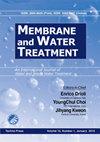Consecutive chemical cleanings of hollow fiber ultrafiltration membranes from a pilot-scale surface water treatment plant
IF 1.1
4区 工程技术
Q4 ENGINEERING, CHEMICAL
引用次数: 2
Abstract
The effects of the order of chemical cleaning protocols on the removal of hollow fiber ultrafiltration (HUF) membrane foulants, and restoration of membrane surface properties, were identified through autopsies of fouled HUF membrane modules from a pilot-scale surface water treatment system (Hongcheon-gun, Kangwon province, Republic of Korea). Quantitative and qualitative differences in the extracted HUF membrane foulants were found to depend on the types of chemical cleaning protocols applied, the consecutive cleaning protocol II (CP II; 0.1 N NaOH -> 0.1 N HCl; the sum of DOC = 215.19 mgC m⁻2; the sum of TN = 17.82 mg N m⁻2; the sum of metals = 25.14 mg m⁻2) extracted both organic and inorganic foulants from HUF membrane surfaces more effectively than consecutive cleaning protocol I (CP I: 0.1 N HCl -> 0.1 N NaOH; the sum of DOC = 189.89 mg C m⁻2; the sum of TN = 13.66 mg N m⁻2; the sum of metals = 9.95 mg m⁻2). Furthermore, the surface morphological characteristics of the cleaned HUF membrane using CP II were relatively similar to the virgin membrane surface compared to those of the cleaned HUF membrane using CP I. These findings demonstrated that the sequential coupling of two different chemical cleaning protocols played critical roles in removing organic and inorganic foulants from the fouled HUF membrane surfaces and restoration of membrane surface elementary composition potentially related to HUF membrane performances.中试地表水处理厂中空纤维超滤膜的连续化学清洗
通过对中试地表水处理系统(韩国江原道洪川郡)中被污染的HUF膜模块进行解剖,确定了化学清洗顺序对去除中空纤维超滤(HUF)膜污染物和恢复膜表面特性的影响。提取的HUF膜污染物的数量和质量差异取决于所采用的化学清洗方案的类型,连续清洗方案II (CP II);0.1 N NaOH -> 0.1 N HCl;DOC总和= 215.19 mgC m毒血症;TN的总和= 17.82 mg N m⁻2;从HUF膜表面提取有机和无机污染物比连续清洗方案I (CP I: 0.1 N HCl -> 0.1 N NaOH)更有效;DOC的总和= 189.89 mg C m毒血症;TN的总和= 13.66 mg N m⁻2;金属总量= 9.95 mg m(2)。此外,使用CP II清洗后的HUF膜的表面形态特征与使用CP i清洗后的HUF膜的表面形态特征相对相似。这些研究结果表明,两种不同化学清洗方案的顺序耦合在去除污染的HUF膜表面的有机和无机污染物以及恢复与HUF膜可能相关的膜表面基本成分方面发挥了关键作用表演。
本文章由计算机程序翻译,如有差异,请以英文原文为准。
求助全文
约1分钟内获得全文
求助全文
来源期刊

Membrane Water Treatment
ENGINEERING, CHEMICAL-WATER RESOURCES
CiteScore
1.90
自引率
30.00%
发文量
0
审稿时长
>12 weeks
期刊介绍:
The Membrane and Water Treatment(MWT), An International Journal, aims at opening an access to the valuable source of technical information and providing an excellent publication channel for the global community of researchers in Membrane and Water Treatment related area. Specific emphasis of the journal may include but not limited to; the engineering and scientific aspects of understanding the basic mechanisms and applying membranes for water and waste water treatment, such as transport phenomena, surface characteristics, fouling, scaling, desalination, membrane bioreactors, water reuse, and system optimization.
 求助内容:
求助内容: 应助结果提醒方式:
应助结果提醒方式:


